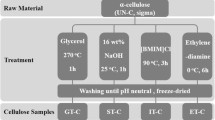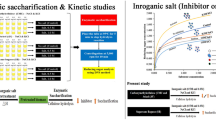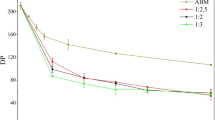Abstract
Cellulose was treated with different extracellular microbial enzymes. The treatment of cellulose with the enzymes can improve alkaline solubility. Both endoglucanase and crude cellulase decreased the average degrees of polymerization (\(\overline{{DP}} \)) and improved the alkaline solubility of cellulose most efficiently. The composition of the enzyme, the type of cellulosic materials, pretreatment, and the treatment conditions are the key factors for its effective processing, using the enzymes to improve on alkaline solubility of cellulose. The improvement in the alkaline solubility is caused by the decrease in \(\overline{{DP}} \) and hydrogen bond because of enzymatic hydrolysis.





Similar content being viewed by others
References
Ago M, Endo T, Hirotsu T (2004) Crystalline transformation of native cellulose from cellulose I to cellulose II polymorph by a ball-milling method with a specific amount of water. Cellulose 11:163–167
Amano Y, Kanda T (2002) New insights into cellulose degradation by cellulases and related enzymes. Trends Glycosci Glycotechnol 14:27–34
Baeza J, Freer J (2001) Chemical characterization of wood and its components. In: Hon DNS, Shiraishi N (eds) Wood and cellulosic chemistry. Dekker, New York, pp 275–383
Bhat MK (2000) Cellulases and related enzymes in biotechnology. Biotechnol Adv 18:355–383
Brown W, Wikstrom R (1965) A viscosity–molecular weight relationship for cellulose in cadoxen and a hydrodynamic interpretation. Eur Polym J 1:1–10
Cao Y, Tan H (2002) The properties of enzyme-hydrolyzed cellulose in aqueous sodium hydroxide. Carbohydr Res 337:1453–1457
Cortez JM, Ellis J, Bishop DP (2001) Cellulase finishing of woven, cotton fabrics in jet and winch machines. J Biotechnol 89:239–245
Elias H-G (1984) Part I, structure and properties. In: Macromolecules. Plenum, New York
Gan Q, Allen SJ, Taylor G (2003) Kinetic dynamics in heterogeneous enzymatic hydrolysis of cellulose: an overview, an experimental study and mathematical modelling. Process Biochem 38:1003–1018
Kamide K (2001) Characterization of chemicaly modified cellulose. In: Hon DNS, Shiraishi N (eds) Wood and cellulosic chemistry. Dekker, New York, pp 621–663
Olkkonen C et al (2000) Degradation of model compounds for cellulose and ligno-cellulosic pulp during ozonation in aqueous solution. Holzforschung 54:397–406
Pere J, Puolakka A, Nousiainen P, Buchert J (2001) Action of purified Trichoderma reesei cellulases on cotton fibers and yarn. J Biotechnol 89:247–255
Rabinovich ML, Melnik MS, Boloboba AV (2002) Microbial cellulases (Review). Appl Biochem Microbiol 38:305–321
Rahkamo L et al (1996) Modification of hardwood dissolving pulp with purified Trichoderma reesei cellulases. Cellulose 3:153–163
Rahkamo L, Siika-aho M, Viikari L, Leppanen T, Buchert J (1998a) Effects of cellulases and hemicellulase on the alkaline solubility of dissolving pulps. Holzforschung 52:630–634
Rahkamo L, Viikari L, Buchert J, Paakkari T, Suortti T (1998b) Enzymatic and alkaline treatments of hardwood dissolving pulp. Cellulose 5:79–88
Rogovina SZ, Zhorin VA, Shashkin DP, Yenikolopyan NS (1989) X-ray diffraction study of cellulose after plastic flow under pressure. Polym Sci USSR 31:1376–1380
Schulein M (2000) Protein engineering of cellulases. Biochim Biophys Acta, Prot Struct Mol Enzymol 1543:239–252
Schurz J (1999) A bright future for cellulose. Prog Polym Sci 24:481–483
Sharrock KR (1988) Cellulase assay methods: a review. J Biochem Biophys Methods 17:81–105
Stubicar N et al (1998) An X-ray diffraction study of the crystalline to amorphous phase change in cellulose during high-energy dry ball milling. Holzforschung 52:455–458
Subramaniyan S, Prema P (2002) Biotechnology of microbial xylanases: enzymology, molecular biology, and application. Crit Rev Biotechnol 22:33–64
van Wyk JPH, Mohulatsi M (2003) Biodegradation of wastepaper by cellulase from Trichoderma viride. Bioresour Technol 86:21–23
Wood TM, Bhat GR (1988) Measurement of cellulase activity. Methods Enzymol 160:87–116
Yen J, Mo Z (2001) Modern polymer physics. Science, Beijing
Author information
Authors and Affiliations
Corresponding authors
Rights and permissions
About this article
Cite this article
Cao, Y., Tan, H. Improvement of alkali solubility of cellulose with enzymatic treatment. Appl Microbiol Biotechnol 70, 176–182 (2006). https://doi.org/10.1007/s00253-005-0069-8
Received:
Revised:
Accepted:
Published:
Issue Date:
DOI: https://doi.org/10.1007/s00253-005-0069-8




